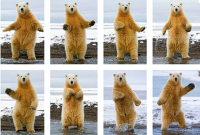News
Latest Lion Aid News
The USA proposes uplisting of polar bears (Ursus maritimus) to Appendix I of CITES
Tuesday 1st January 2013

Current estimates of polar bears stand at 20,000 to 25,000 versus our recent estimate of African lions of 15,000 to 16,000. The USA Fish and Wildlife Service (their wildlife management agency) is entirely correct in pointing out that between 2001-2010, 6798 polar bear products (live animals, bodies, skins, skulls and trophies) have been listed by CITES as being exported from the polar bear range states. Hence their proposal to CITES to protect polar bears from future trade. Canada, a country we seem to associate with a “green” conscience, is responsible for over 79% of such exports. Canada exported 99% of all polar bear hunting trophies, 79% of polar bear skins, and 95% of polar bear “bodies” according to CITES records. Canada is opposed to the uplisting of polar bears to CITES appendix I as is the WWF – despite the huge trade in polar bear items, Canada and WWF feel that climate change and not trade is the biggest threat. That could well be so, but why continue to allow commercial offtake of a species under great threat? And realizing that those 6798 polar bear products exported over the ten years 2001-2010 do not account for a possibly equally large internal consumption by range states not recorded by CITES numbers? Canada allows “traditional” hunting by indigenous Inuit people – aka Eskimos – but this also needs to cease. Traditional hunting, if so important to the Inuits, should be conducted with traditional methods, not including high-powered rifles and snowmobiles. And the products of traditional hunts should not be allowed to be sold on the international markets as they now are. It is akin to the Kenya Government saying that since the Maasai people traditionally hunted lions, they should be given current fiat to do so and also sell products like skins, bones, skulls, teeth, claws… on the international market. And hunt those lions with rifles and vehicles rather than on foot with spears. So where are all Canada’s polar bear skins exported to? You might be surprised. From 2001 to 2101, Japan imported 975, USA 463, Norway 299, Russia 125. Why do countries like Japan, USA and Norway have such a desire to import skins from an endangered species? And you will be further surprised that China has become a major player by importing 331 skins 2006-2010. Yes indeed, China is now becoming greatly interested in polar bear products. In addition to those skins, China has recently become a recently significant importer of polar bear trophies and bodies. It is high time that polar bears are placed on CITES Appendix I by CITES (the last proposal in 2010 was defeated) and that WWF stops opposing such proposals. The melting polar ice cap will endanger polar bears in the future, but growing commercial offtake in the present will destroy populations faster than climate change. Picture credit: http://bit.ly/YL3t1Y Tags: Hunting, CITES, USFWS, China, Appendix 1, Canada, climate change, polar bears, Arctic, Inuit people, Categories: Politics and Wildlife |
Posted by Pieter Kat at 16:39
No comments have been posted yet.
Add a new comment
Existing user
New user sign up



